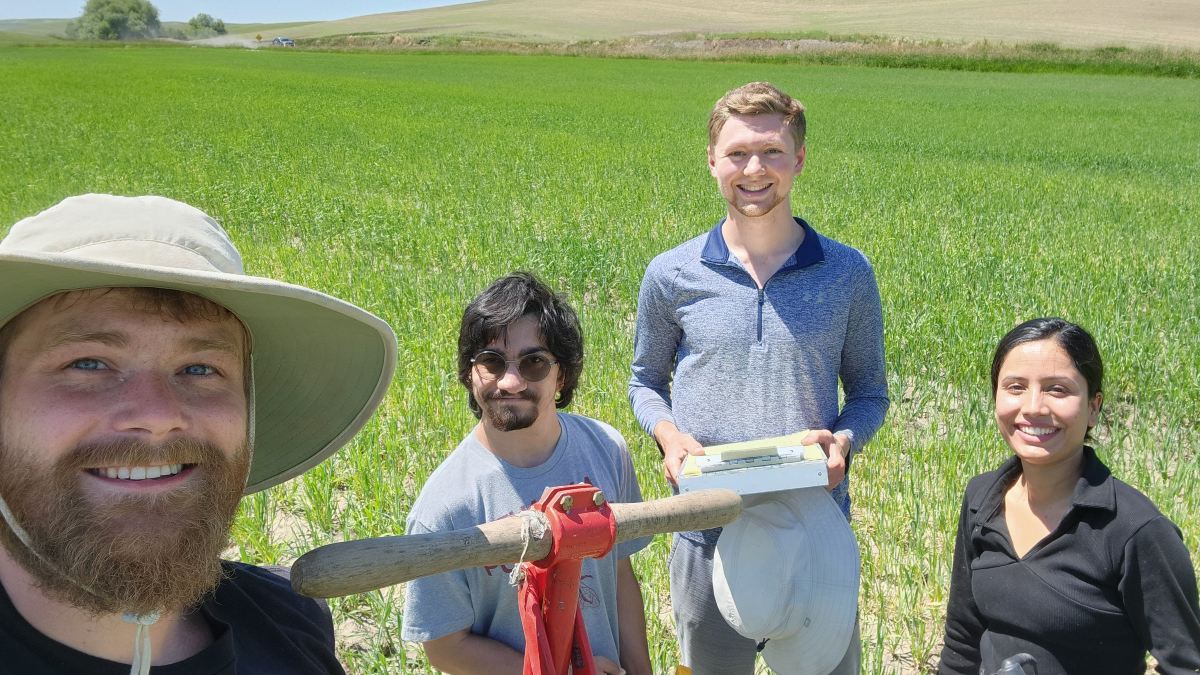Soilborne Crop Helpers
July 24, 2024
University of Idaho researchers studying farm fields in the Palouse region have unearthed strong evidence that increasing diversity in agricultural systems benefits soil arthropod communities, which in turn improve crop productivity.
Through their research, Dane Elmquist, who recently graduated from the University of Idaho with a doctorate in entomology, and his major professor, University Distinguished Professor Sanford Eigenbrode, provided baseline data of soil arthropod communities inhabiting Palouse farmland, as well as how farming practices influence those communities. The data will allow researchers to monitor changes in Palouse soil arthropod populations over time and guide work aimed to improve overall health of agricultural soils.
Arthropods are invertebrates with jointed legs and bodies with a hard exoskeleton. About 23% of all described organisms live in soil, and 85% of those are arthropods. Examples of soilborne arthropods include mites, springtails, centipedes, ants, spiders, beetles and pill bugs.
“These soil arthropods are kind of a neglected piece of the puzzle. They’ve received a lot less research attention compared with their microbial counterparts in the soil, as well as earthworms,” said Elmquist, who earned his doctorate last December and is now working for University of Wisconsin-Madison Extension. “We really didn’t know much, if anything, about the soil arthropod communities of the Palouse agricultural ecosystems prior to our project.”
Soil arthropods are critical to soil health as they decompose crop residue, thereby releasing nutrients that support crop growth. They also interact closely with important soil microbial communities and help control soilborne pests.
Elmquist based his dissertation on the research. His project includes five chapters – three have been published in scientific journals and one chapter is under review for publication. He and Eigenbrode have also published an Extension bulletin on their work through U of I.
The soil arthropod work was funded by three grants. It was part of the multidisciplinary, $4.1 million Landscapes in Transition (LIT) project, which was funded by USDA and assessed how diversification of agricultural practices in the Palouse impacted the entire farming system. Elmquist also obtained a $120,000 USDA National Institute of Food and Agriculture predoctoral grant covering associated greenhouse work and a $25,000 USDA Western SARE graduate student grant.
From 2018-2022, researchers planted on-farm strip trials and small plots to compare arthropod populations in conventional crop rotations with more diversified rotations — including winter pea in place of a legume or a fallow period, single-species cover crops and multi-species spring cover crops. The diversified rotations, especially the addition of winter peas and multi-species cover crops, resulted in a far richer diversity of soil arthropods
“We did find an effect of above-ground diversity on below-ground diversity,” Elmquist said, adding the greater diversity of soil arthropods persisted into later planted winter wheat.
Furthermore, they confirmed an increase in arthropod-mediated litter decomposition in wheat plots that followed multi-species cover crops.
Through their combined studies, they evaluated more than 950 soil samples for arthropods, counting more than 120,000 individual arthropods and identifying more than 70 arthropod taxa.
“I was surprised by the number and diversity of the arthropods we pulled from these agricultural ecosystems that have been farmed relatively intensively for the last 100 years,” Elmquist said.
Elmquist extracted arthropods from soil samples taken from experimental plots using a tool known as a Berlese-Tullgren funnel. A light bulb heats and dries the soil, forcing the arthropods further away until they fall from the mouth of a funnel into a preservative. Elmquist also modified the funnel to capture them alive for use in greenhouse experiments.
After counting the arthropods and recording their family, Elmquist added them to soil in pots to grow wheat plants in a greenhouse. He discovered the presence of arthropods had a profound effect on strengthening wheat root systems and increasing above-ground plant biomass.
“The roots were generally longer, there were more of them and they had more tips and branches, which are important for nutrient scavenging,” Elmquist said, adding soil arthropods also increased the plant biomass above ground.
The researchers also noticed in their greenhouse research that when aphids were placed on plants, populations of arthropods in the soil became more robust. Conversely, arthropods in the soil correlated with more aphids on foliage.
More research is needed to understand the mechanisms behind the correlation between soil arthropods and insects feeding above ground, as well as the improved plant root development triggered by soil arthropods.
Eigenbrode and Elmquist collaborated with U of I’s former head of the Department of Soil and Water Systems, Jodi Johnson-Maynard, to compare using the presence of soil arthropods as an indicator of soil health against more traditional methods of assessing soil health. They see great promise in the approach, which warrants additional research.
“Soil arthropods affect the growth and potential profitability of wheat production in our region, and this is why producers should become aware of this work,” Eigenbrode said. “Take care of your below-ground livestock. That’s part of taking care of your whole production system, and we’ve provided some data that underscores that it’s not just handwaving. It’s real.”

About the University of Idaho
The University of Idaho, home of the Vandals, is Idaho’s land-grant, national research university. From its residential campus in Moscow, U of I serves the state of Idaho through educational centers in Boise, Coeur d’Alene and Idaho Falls, nine research and Extension centers, plus Extension offices in 42 counties. Home to nearly 11,000 students statewide, U of I is a leader in student-centered learning and excels at interdisciplinary research, service to businesses and communities, and in advancing diversity, citizenship and global outreach. U of I competes in the Big Sky and Western Athletic conferences. Learn more at uidaho.edu.






